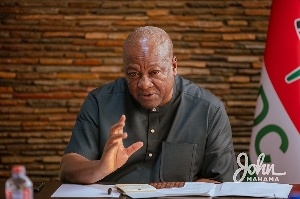Opinions of Saturday, 12 April 2014
Columnist: Shaban, Abdur Rahman Alfa
1999 – Birth of NRSC: Year of Action on Road Safety
‘Fatalities and injuries contribute substantially to a countries’ cycle of poverty. They shatter families, rob society of bread winners, deprive businesses of skilled labour, deplete family incomes and savings through massive health related debts, consume hospital resources and hinder local economic development and growth’ – Yaw Boateng Gyan, Chairman of NRSC Board of Directors.
Introduction
The roads are by far the most patronized mode of transport in our part and most parts of the world. Enough reason why at any point the components that go into making the roads safe and serene cannot be underestimated.
Whatever the class and quality of the road (be it first or second class, feeder or urban road) the incontrovertible fact is that, there must be laid down rules and regulations governing conduct of the different subjects inter-playing on the road.
Roads have been constructed since colonial days and would continue to be built as far as different geographical and population dynamics play out within particular time frames – to ease congestion and or fit the status of a place.
1999 as a starting point
1999 is labeled a year of action relative to road safety given that for the first time, there was a legal entity tasked with coordinating activities of other state agencies in the crucial fight of reducing road accidents to the barest minimum.
Assented to, on the 22nd of April, 1999 what has become known as ACT 567 states as follows in the beginning: ‘The five hundredth and sixty – seventh act of the parliament of the republic of Ghana entitled NATIONAL ROAD SAFETY COMMISSION ACT, 1999; AN ACT to establish a National Road Safety Commission; provide for its functions relating to the development and promotion of road safety in the country and to provide for connected matters.’
That National Road Safety Commission (NRSC) Act expatiates further in section 2 clauses 1 and 2 the object and functions of the commission.
Clause 1 states thus: ‘The object of the commission is to develop and promote road safety in Ghana and to CO-ORDINATE (caps mine) policies in relation to them.’
The Coordinating Role of NRSC
When several legally mandated groups are put in charge of any responsibility, there is likely to be a disjoint if there isn’t that ‘bolt and nut’ to hold them all in place, to smoothen rough edges and or do the much needed evaluation.
That is the primary role that the NRSC is by law supposed to spearhead. Other 15 functions of the commission in clause 2 earlier referred to are amongst others:
• Undertake nationwide road safety education
• Encourage the development of road safety education as part of the curriculum and the training of teachers in road safety.
• Carry our special projects for the improvement of road safety
• Coordinate, monitor and evaluate road safety activities, programmes and strategies.
In the conduct of their activities, the NRSC is tasked with liaising and co – operating with, consulting with, collaborating with and making recommendations to different state institutions on relevant road safety measures.
They are tasked in point (e) and (h) to make recommendations to the Minister on efforts aimed at preventing road accidents and advising the Minister on the formulation of road safety policies and programmes respectively.
With respect to the Driver and Vehicle Licensing Authority (DVLA), the NRSC has to liaise with them and any such bodies to promote road safety.
The Building and Road Research Institute (BRRI) and the Ghana Standards Authority (GSA) etc. are also to work in consultation with NRSC to set standards for road safety equipments and ensure compliance with standards.
Board Membership: A Reflection of the NRSC’s Importance
There are eighteen members on the NRSC board. Headed by the chairman, representatives are pooled from six ministries namely: Roads and Transport, Local Government and Rural Development, Health, Education, Communication and Justice & Attorney General.
Then there is the executive director of the commission, plus representatives from the Motor Traffic and Transport unit of the Ghana police Service, the Ghana Armed Forces, the National insurance Commission, National Association of Driving Schools.
The remaining are representatives from the Broadcasting industry, the Ghana Journalists Association, the Building and Road Research Institute, the Driver and Vehicle Licensing Authority and the Ghana Insurers Association.
Then there are three representatives from the private providers of road transport, the Ghana Private Road Transport Union (GPRTU), the Private Transport Owners Association (PROTOA) etc.
The composition of the NRSC board, aggregates experiences, expertise and energies into giving direction to the activities of the NRSC aimed at achieving the core aim as above stated; “… to develop and promote road safety in Ghana and to co-ordinate policies in relation to them.”
Also in 1999 was the passage of Act 569 which established the Driver and Vehicle Licensing Authority Act which replaced the Vehicle Examination and Licensing Division (VELD).
In the next piece on this series on road safety, we do a comparative analysis of what the licensing laws say in relation to issuance of driving licenses and vehicle registration vis-à-vis the very disturbing contents of Anas Aremeyaw Anas’s latest anti corruption exposé, Ghana’s Soul Takers.
Till then, drive safe, for you know not who is behind the next wheel.
Shaban Abdur Rahman Alfa
newcguide@gmail.com
--
ABDUR RAHMAN ALFA SHABAN












